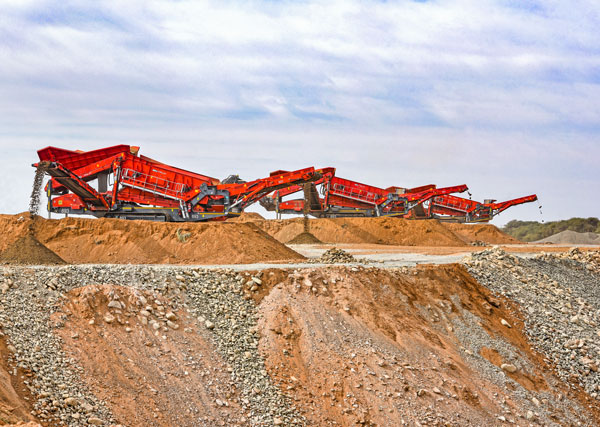Finlay Screens are flawless gems for Steyn Diamante

You may be forgiven if you haven’t heard of the Schutsekama Diamond Mine on the Riet River near the village of Ritchie, which lies south of Kimberley. It is not a mine where the skyline is dominated by a shaft tower. Here in fact, the only raised portion shows four large red mobile Finlay Screens processing a constant stream of rock, gravel and sand that is separated onto different moving belts which spew the material into heaps.
Archaeological data shows that the narrow Riet River ran a lot wider some centuries ago. Alluvial diamonds from as far as the present day Jagersfontein and Koffiefontein were pushed into the surrounding areas as the river flooded the plain en route to joining the Vaal River further downstream.
This is where Schalk Steyn of Steyn Diamante, doyen of alluvial diamond mining in South Africa, established one of his mining operations in 2015. The Schutsekama Mine Manager is Wikus de Winnaar and we asked him what makes their mining methods work in that area.
“Compared to traditional alluvial mining methods, we’ve gone considerably bigger on this site using a 240-tonne excavator for loading 100-tonne rigid dump trucks. They, in turn, deposit the diamond-bearing gravel onto stockpiles from where huge 50t excavators feed the material into Finlay 893 Screens for separation,” he explains. “Anything larger than 125mm is returned to the mining pit to form the basis of rehabilitation and finer material than that is sent to the processing plant.”
“During April 2018, we fed 159 957 tonnes of run-of-mine material through three Finlay 893 Screens or which proves that we couldn’t mine so sustainably and on such a large scale if it weren’t for our fleet of Finlay 893 Screens. We have four in a row here but use only three actively, keeping the fourth in reserve for when any of the others need maintenance. Regular rotation also takes place so that the load is spread amongst the four machines.”
The Schutsekama mine works daytime shifts from Monday to Saturday with month-end long weekends. Machine hours are clocked relentlessly, especially on the Finlay 893 Screens. At the time of writing, the newest machine showed 340 hours and the oldest 5 477 hours.
The Finlay 893 Screens are placed as close to the mining areas as possible to shorten the haul distance. This works as the rigid trucks run full in both directions, bringing mined material to the stockpiles beside the Finlay Screens and returning with oversized material for roll-over rehabilitation.
“Because of the area where we mine, we come across a lot of wet clay, sand and shale in the diamond-bearing gravels, but we can throw anything at these Finlays and they separate what we don’t want from that which goes to the plant – they are simply amazing.”
According to Wikus, the present four Finlay 893 Screens were bought relatively recently as replacements for four older machines which were sold out of hand. It’s a well-known fact in the alluvial mining industry that Finlay Screens from Steyn Diamante have been well maintained and they are therefore sought after on the pre-owned market.
Fuel is a major cost factor to any miner and this site consumes 8 500 litres of diesel a day. The Finlay 893 Screens have been recording fuel burn of around 20 litres an hour and, considering what they produce, this is considered low.
“Schalk first used Finlay 883 Screens back in 2004 when he started mining alluvial diamonds in South Africa,” Wikus continues. “He knows the machines’ capabilities and while going on to the larger 893 machines has stayed with Finlay as he has absolute faith in the brand.”
“What we appreciate, as the mining teams and those working with the Finlay Screens daily, is that we have the backing of Bell Equipment in terms of technical support and parts supply. We get great service from Shaun Malan and his whole team at the Bell Customer Service Centre in Kimberley and even if parts are not in stock, a plan is always made to supply us quickly,” he adds. “Mining equipment will need attention and can surprise you at any time but knowing Bell Equipment is close by, allows us to do what we do best – mine diamonds and rehabilitate the land afterwards.”
.png?sfvrsn=f0a0ba14_0)